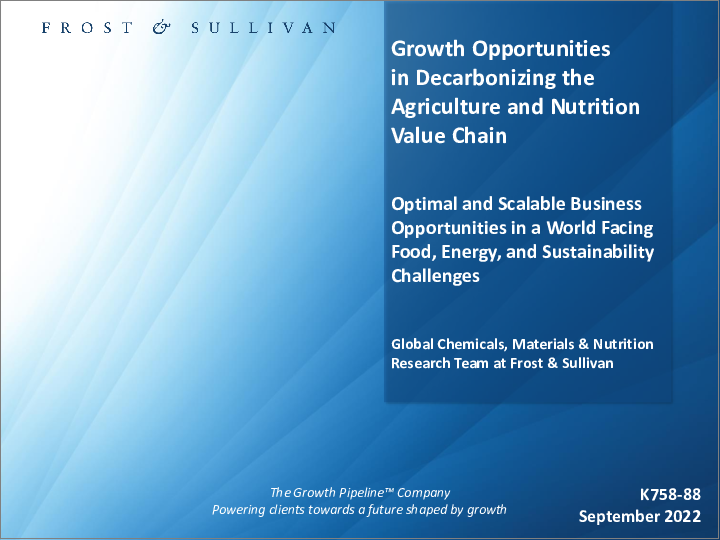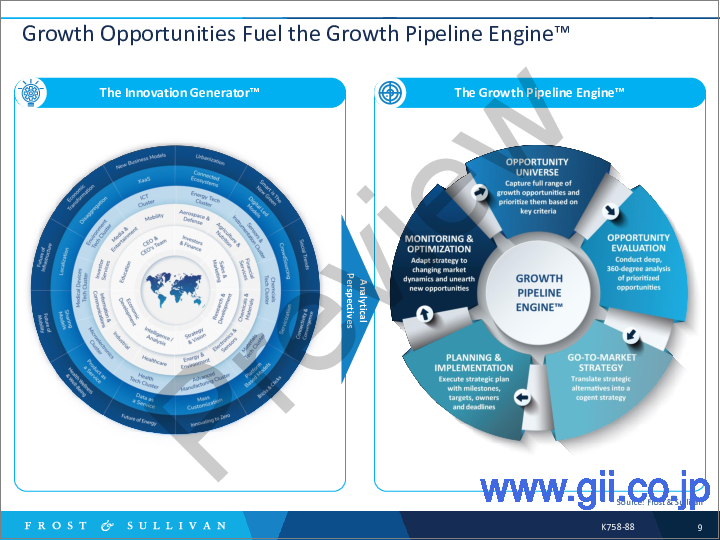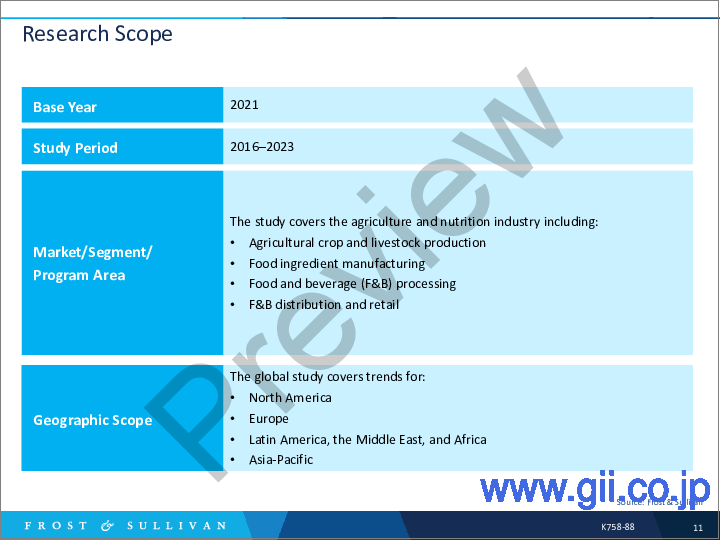|
|
市場調査レポート
商品コード
1137095
農業と栄養のバリューチェーンの脱炭素化における成長機会Growth Opportunities in Decarbonizing the Agriculture and Nutrition Value Chain |
||||||
| 農業と栄養のバリューチェーンの脱炭素化における成長機会 |
|
出版日: 2022年09月22日
発行: Frost & Sullivan
ページ情報: 英文 59 Pages
納期: 即日から翌営業日
|
- 全表示
- 概要
- 目次
当レポートでは、農業と栄養のバリューチェーンの脱炭素化について調査分析し、業界動向、地域別の脱炭素化の動向、成長機会などを提供しています。
目次
戦略的必須事項
- 成長がますます困難になっているのはなぜか?
- The Strategic Imperative 8(TM)
- 農業と栄養のバリューチェーンの脱炭素化に対する上位3つの戦略的必須事項の影響
- 成長機会がGrowth Pipeline Engine(TM)を促進
市場概要
- 調査範囲
- 農業と栄養のバリューチェーンの概要
- 農業と栄養のバリューチェーンの脱炭素化
- F&Bメーカーのハイライト上位20:スコープ1および2 GHG排出削減目標
- 主な動向
- F&B企業の脱炭素化のギャップと課題
- 脱炭素化におけるF&Bのリーダーとラガード
- 2023年の主要予測
成長機会分析
- 業界動向
- カーボンニュートラルの達成
- バリューチェーンの脱炭素化
- 農業からのGHG排出量:世界
- 農業からのGHG排出量:欧州連合およびロシア
- 農業からのGHG排出量:米国とブラジル
- 農業からのGHG排出量:中国とインド
- 農業からのGHG排出量:世界のその他地域
- 主要な食品・作物のカテゴリーからのGHG排出量
- 食生活の変化による脱炭素化
- F&Bメーカーのハイライト上位20:スコープ1および2 GHG排出削減目標
- 加工食品生産における制御可能な脱炭素化とは
- GHG排出量に直接影響を与える制御可能な対策とは
- 再生農業は、炭素隔離を可能にする土壌再生に焦点を当てた6原則の概念であり、ここ数年、大企業は再生農業の実践を促進するイニシアチブを発表している。
- 調査によると、隔年で豆類を輪作するデュラム小麦の生産者は、そうでない生産者よりも温室効果ガスの排出量が少ないことが示されており、同じ現象が現在の油糧種子農家にも当てはまると予想される。
- 食料とエネルギーの安全保障
- 利害関係者のエコシステム
- 利害関係者のエコシステム: 主要な利害関係者者
- 利害関係者のエコシステム-:技術提供者
- 利害関係者のエコシステム:インテグレーターおよびソリューションプロバイダー
地域別の成長機会
- 欧州
- アジア太平洋
- 北米
- ラテンアメリカ、中東、アフリカ
成長機会領域
- 成長機会1:再生型農業のカーボンオフセットクレジット
- 成長機会2:アグリボルタイック
- 成長機会3:コンテナベースの温室
- 図表一覧
- 免責事項
Optimal and Scalable Business Opportunities in a World Facing Food, Energy, and Sustainability Challenges
This research service provides qualitative analyses of drivers of decarbonizing the agriculture and nutrition value chain. The research analyzes the impact of different types of greenhouse gas (GHG) emissions on the value chain and highlights the reduction initiatives and targets of stakeholders across the food and beverage value chain. It explores the key industry drivers for decarbonization and includes an in-depth analysis of trends, providing insights into measures that can lead to a lower carbon footprint across the value chain.
The regional markets in the scope of the research include North America, Europe, Asia-Pacific, Latin America, and the Middle East and Africa. Regional decarbonization trends have been included in the research study.
The research service also highlights the stakeholder ecosystem and the role and influence of each participant in the decarbonization of the agriculture and nutrition value chain. Perspective on the leaders in the food and beverage decarbonization strategy have been entailed along with top the 20 players classified based on their GHG emissions reduction targets.
Table of Contents
Strategic Imperatives
- Why is it Increasingly Difficult to Grow?
- The Strategic Imperative 8™
- The Impact of the Top 3 Strategic Imperatives on Decarbonizing the Agriculture and Nutrition Value Chain
- Growth Opportunities Fuel the Growth Pipeline Engine™
Market Overview
- Research Scope
- Agriculture and Nutrition Value Chain Overview
- Decarbonizing the Agriculture and Nutrition Value Chain
- Top 20 F&B Producer Highlights-Scope 1 and 2 GHG Emission Reduction Targets
- Key Trends
- F&B Companies' Decarbonization Gaps and Challenges
- F&B Leaders and Laggards in Decarbonization
- Top Predictions for 2023
Growth Opportunity Analysis
- Industry Trends
- Achieving Carbon Neutrality
- Decarbonizing the Value Chain
- Decarbonizing the Value Chain (continued)
- GHG Emissions from Agriculture-Global
- GHG Emissions from Agriculture-European Union and Russia
- GHG Emissions from Agriculture-United States and Brazil
- GHG Emissions from Agriculture-China and India
- GHG Emissions from Agriculture-Rest of World
- GHG Emissions by Major Food/Crop Category
- Decarbonizing through Dietary Changes
- Top 20 F&B Producer Highlights-Scope 1 and 2 GHG Emission Reduction Targets
- Focus on What Is Controllable-Decarbonizing Processed Food Production
- Focus on What Is Controllable-Decarbonizing Processed Food Production (continued)
- Focus on What Is ControllableMeasures to Directly Impact GHG Emissions
- Regenerative farming is a 6-principle concept that focuses on soil rehabilitation to enable carbon sequestration. In the last few years, large corporations have announced initiatives to promote regenerative farming practices.
- Learning to be Carbon Responsible-Regenerative Farming (continued)
- Further research shows that durum wheat growers who rotate in pulse crops every other year will emit less GHG than those who do not. The same phenomenon is expected to apply to current oilseed farmers.
- Food and Energy Security
- Food and Energy Security (continued)
- Food Energy Security (continued)
- Food Energy Security (continued)
- Stakeholder Ecosystem
- Stakeholder Ecosystem-Primary Stakeholders
- Stakeholder Ecosystem-Technology Providers
- Stakeholder Ecosystem-Integrators and Solution Providers
Growth Opportunities by Region
- Europe
- Asia-Pacific
- North America
- Latin America, Middle East, and Africa
Growth Opportunity Universe
- Growth Opportunity 1: Regenerative Agriculture Carbon Offset Credits
- Growth Opportunity 1: Regenerative Agriculture Carbon Offset Credits (continued)
- Growth Opportunity 2: Agrivoltaics
- Growth Opportunity 2: Agrivoltaics (continued)
- Growth Opportunity 3: Container-based Greenhouses
- Growth Opportunity 3: Container-based Greenhouses (continued)
- List of Exhibits
- Legal Disclaimer




